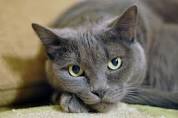An interesting article on hyperthyroidism in cats
Background
Exclusive feeding of an iodine-restricted diet has been proposed as a method for controlling clinical manifestations of hyperthyroidism in hyperthyroid cats.
Objectives
To determine the effect of feeding an iodine-restricted diet on TT4 concentrations and clinical signs in cats with spontaneous hyperthyroidism.
Animals
Forty-nine client-owned cats with spontaneous hyperthyroidism.
Methods
Retrospective case series. Hyperthyroid cats were exclusively fed a commercially available iodine-restricted diet. Clinical response was assessed by change in weight and heart rate and serum TT4, blood urea nitrogen (BUN), and creatinine concentrations at various times during dietary management (21–60 days, 60–180 days).
Results
Serum TT4 normalized in 20/48 cats (42%) and 39/47 cats (83%) at 21–60 days and 61–180 days, respectively. Cats in which the TT4 concentrations were still above reference range at 21–60 days had a significantly higher starting TT4 than those that normalized their TT4 levels during the same time period (P = .038). Body weight did not significantly increase (P = .34) nor heart rate decrease (P = .64) during the study. There was a significant decrease in serum creatinine (P = .028). Cats in the low reference range for serum TT4 concentrations did not have a significant increase in body weight (P = .41) nor creatinine (P = .54) when compared to those with high reference range.
Conclusions and Clinical Importance
Restricted-iodine diets were effective at maintaining serum TT4 concentrations within reference ranges for a majority of cats with spontaneous hyperthyroidism over 1 year, although not all clinical signs of hyperthyroidism improved.
Click here to be directed to the study.

